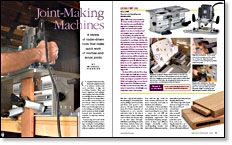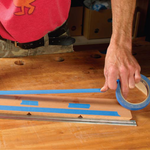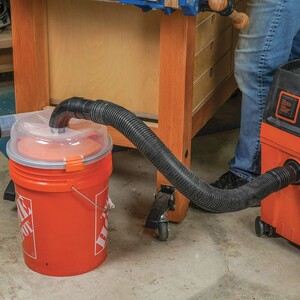Joint-Making Machines
A review of router-driven tools that make quick work of mortise-and-tenon joints
Synopsis: Why buy a factory-made jig to make mortise-and-tenon joints when you can make serviceable alternatives? Michael Standish reviews several brands to justify the use and cost of buying them for even small-scale production work. Before taking the plunge yourself, check out his tests to see which jig serves your needs most effectively.
From Fine Woodworking #168
Compared with more fundamental equipment such as jointers, mortise-and-tenon machines, or jigs, are woodshop luxuries. They can feature ingenious and sophisticated designs, but in the end, like dovetail jigs, they are adjuncts to routers. Jigs are not cheap either: The models surveyed here are priced from a little over $400 to about $700, router not included. With some forethought and care in the making, serviceable shopmade versions are fairly straightforward and inexpensive to construct. So why buy a factory-made one?
A proper jig serves two basic woodworking functions: securing a workpiece and guiding a cutter. The jig should perform without surprises and without fail. Also, a jig should enhance the advantages of machine joinery by adding control (and thus precision) and speed to the process. The jigs in this article meet all of these demands, allowing you to cut a mortise-and-tenon joint in the time it takes to hone a chisel. Although some of them also feature ways to cut other joints (through-, half-blind, and sliding dovetails; box joints; dadoes; fancy pin-and-crescent joints), for this review I wanted to learn only how well the jigs could cut basic mortise-and-tenons, the most commonly used joint in furniture and cabinetry.
The makers of these machines have already done much of the head-scratching for you (How to center the cut? Will the clamps interfere? Is the router adequately supported?). The streamlined clamping arrangements of these very different designs drastically reduce stock-handling hassles, and their refined adjustment mechanisms allow precisely and predictably fitted joints.
All of these jigs will require an hour or longer for assembly, and you’ll need several times that to familiarize yourself with how they work. Some particular operations, such as cutting the joints for a set of different-size cabinet doors, will entail additional time for individual setups. Regardless of your woodworking style or mechanical aptitude, the latter prep work typically is measured in minutes, while the machining itself takes even less time. Results, of course, will vary. But with a good router and a sharp bit, you reasonably can expect to produce between one and four consistently crisp mortises or tenons per minute with any of these jigs.
I tested these jigs with a 15-amp Elu plunge router, run at the same speed setting, using the same solid-carbide spiral upcut bit. I machined mortises and single tenons, approximately 1 in. by 3 in. in profile, with all of these jigs. Material for the test samples came from the same bundle of mahogany-like substitute decking purchased from a local lumberyard. I tested these machines by cutting roughly two dozen mortises and two dozen tenons on each of them.
For the full article, download the PDF below.
Fine Woodworking Recommended Products

3M Blue Tape

Dustopper Pro

Estwing Dead-Blow Mallet






















Log in or create an account to post a comment.
Sign up Log in